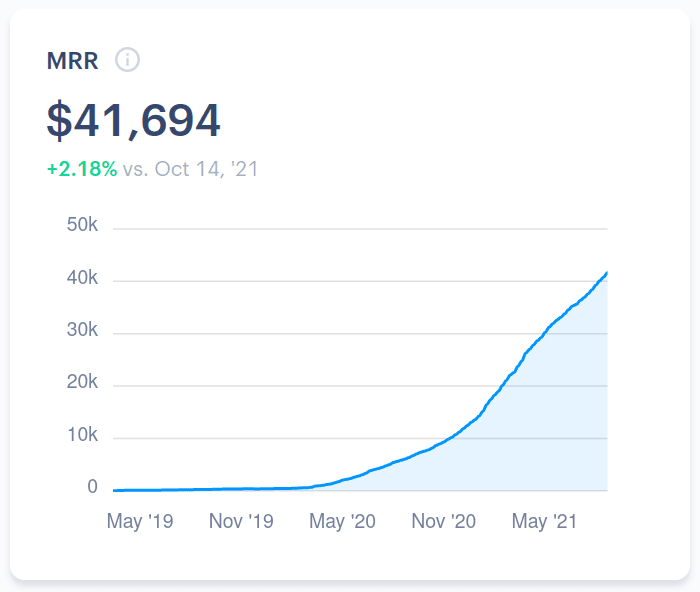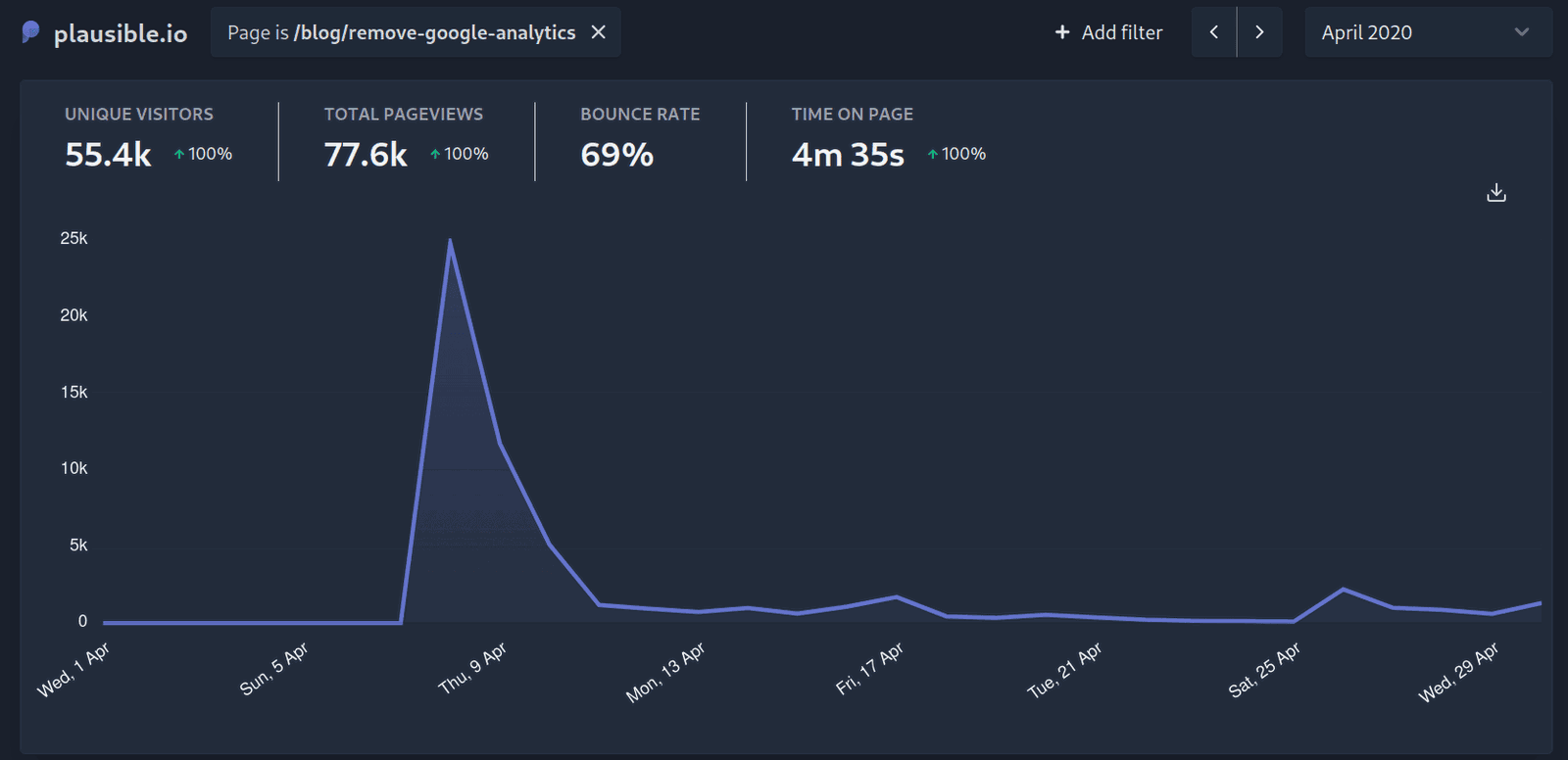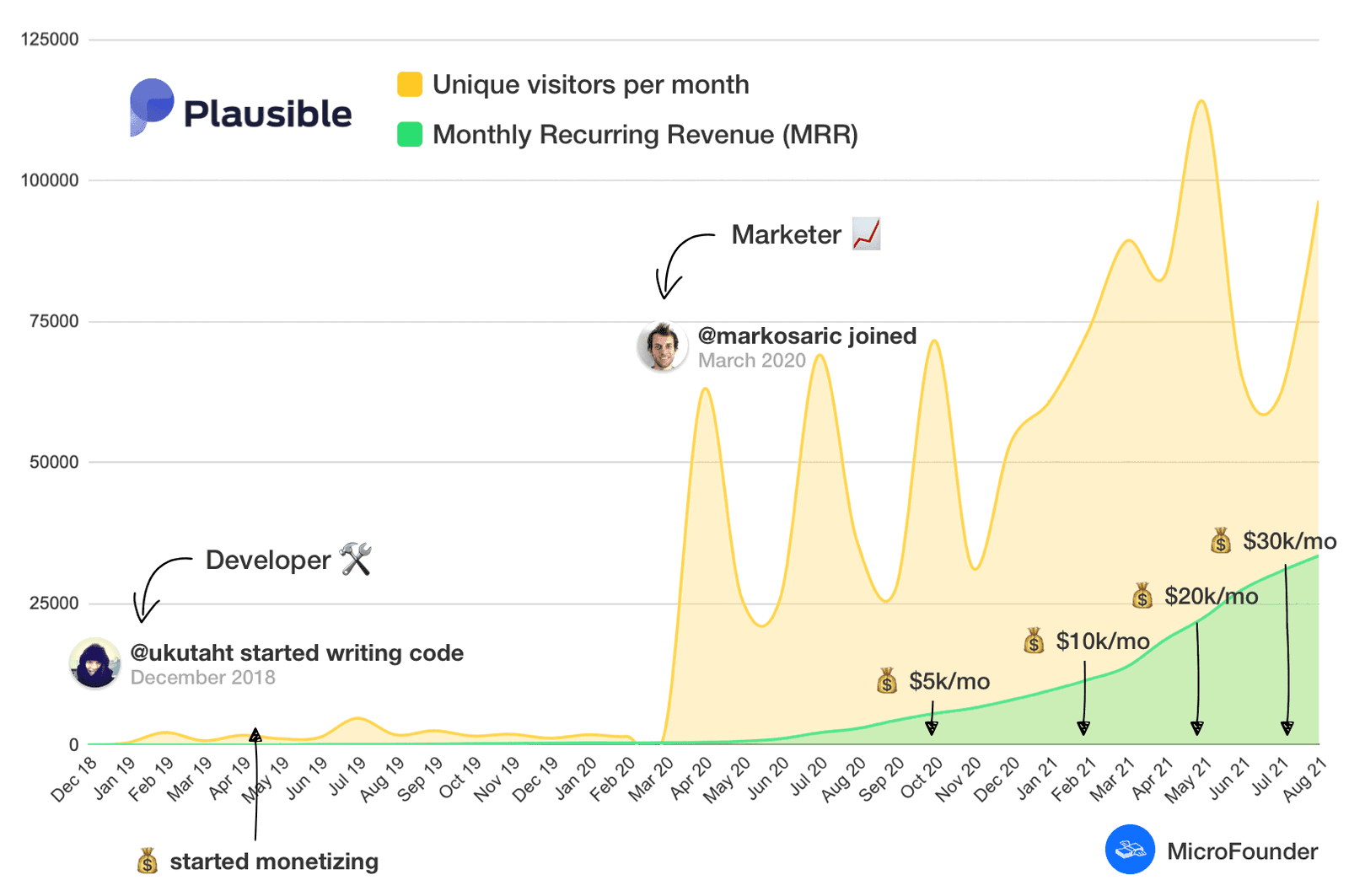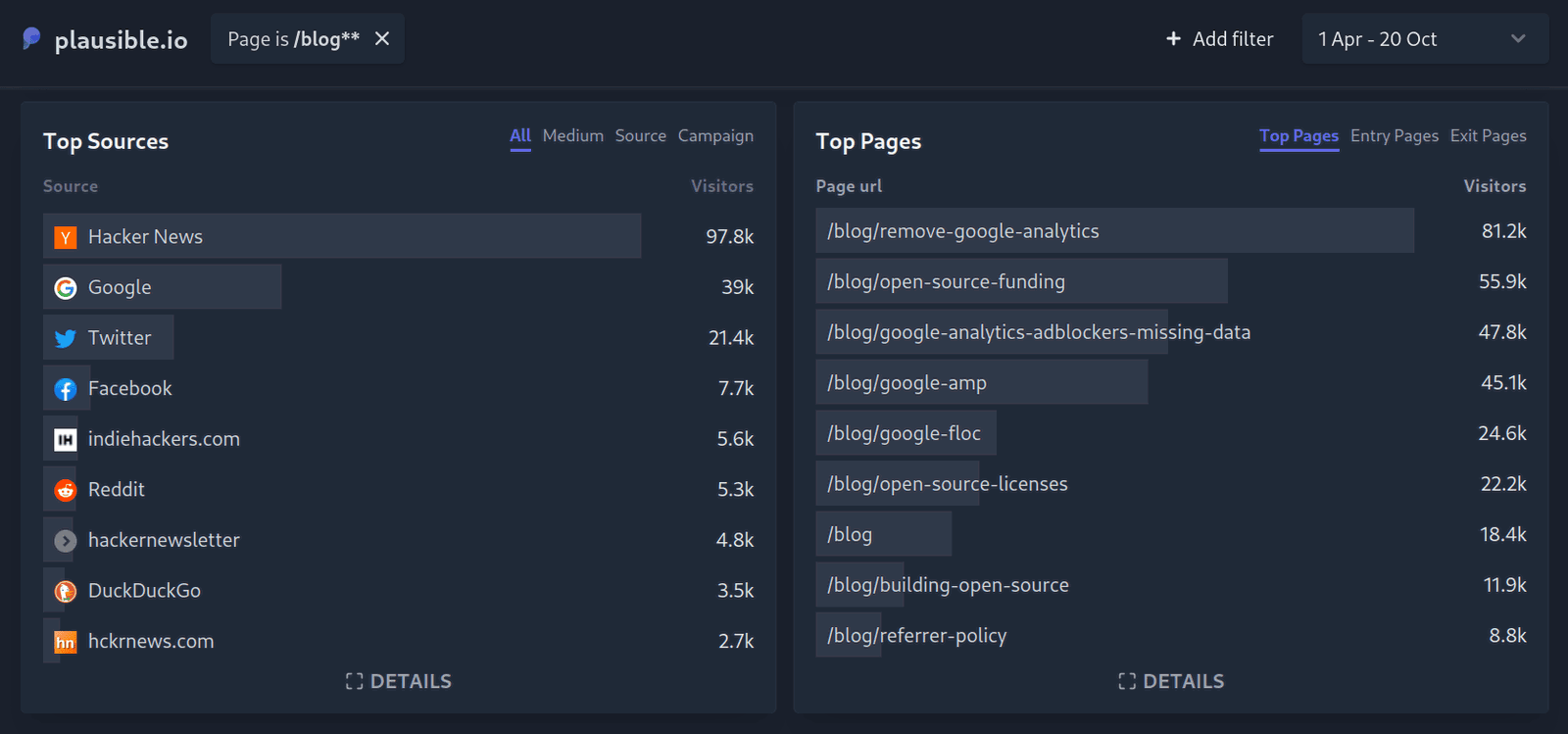How we bootstrapped our Google Analytics alternative to $500k ARR

We’ve had an amazing journey to date. It took us 324 days to reach $400 in monthly recurring revenue (MRR) since we got our first paying subscriber on May 14 2019. Then things got a bit crazy.
It took us just nine months to go from $400 to $10k MRR, and now, ten months after the $10k MRR milestone, we’re at $500,000 annual recurring revenue (ARR).
It’s been an incredible ride for our bootstrapped, open source and privacy-first alternative to Google Analytics. The graph above that shows our MRR growth to date is worth a thousand words.
If you’re new to Plausible, here’s a brief overview of who we are and how we got here.
- What happened in April 2020 with that first big spike
- We don’t waste any time obsessing over investors
- We do more with less
- Open source and transparency are an advantage to us
- How we got our first visitors and customers
- Milestones are cool but they’re not what’s making a difference
- How we’ll get to $1M ARR
What happened in April 2020 with that first big spike
Let’s get this out of the way first as we get this question pretty much every time that we share our MRR chart.
We published a blog post on April 8 2020 and it got the attention of Hacker News with more than 50,000 people reading the post in the few days after being published.
For some context, we had a total of 27,300 unique visitors in 15 months before publishing that post. We also got 166 new trials in the first week after the post which is more than what we got in four months in total prior to it.
The post was titled “Why you should stop using Google Analytics on your website”. You can pretty much say that one single blog post changed the traction of our startup.
Here’s the traffic to that single blog post in April 2020:

Obviously, in the year and a half since then, we’ve put a lot of effort into improving our product, the infrastructure and several other blog posts have helped us along the way, but we wouldn’t be where we are today without that first standout post.
Read more about these early days and the steps we took in “how one blog post changed the traction for my startup”.
We don’t waste any time obsessing over investors
Unlike the more common startup story, we’re entirely self-funded and bootstrapped. The two of us, as co-founders, completely own Plausible Analytics. We haven’t taken anyone’s money, so we fully control where we take Plausible next.
Last year, we went several months without any salaries living from personal savings while growing Plausible. It was challenging and we were down more than $50,000 in savings between us. Now that we’re sustainable, we can pay our bills and salaries directly from Plausible’s revenue. It feels great.
Both my co-founder Uku and I worked at venture-funded startups before Plausible. Some things are different when you’re bootstrapping.
The best thing about being bootstrapped is that we don’t waste any time obsessing over investors and their wants—no calls, meetings, reports, presentations and expectations. Instead, we only obsess about our customers, their needs and about removing Google Analytics from the web.
We do miss out on getting featured in the tech media. TechCrunch published a story about our growth once (thanks to the VCs who were sharing a list of fastest growing open source startup) but otherwise, we get no coverage that VC-funded startups get.
It is easy to get covered by the tech media when you raise money, while it is pretty much impossible to get covered by being a profitable, $500k ARR startup. It feels a bit upside down as having a sustainable and thriving startup is a much more complicated and more noteworthy accomplishment than raising money.
Read more about our values and principles behind Plausible.
We do more with less
Another great benefit of being bootstrapped is that it forces us to be resourceful. We do more with less. Money was tight, resources were limited and the time was short. These are the constraints that venture-funded companies don’t have, so they never learn how to be resourceful and use situations like these to their advantage.
Resourcefulness is an advantage to us. We manage our server infrastructure, we do our marketing without paying experts or influencers, and we speak to the customers and respond to customer enquiries ourselves.
Today we’re running a business with almost 5,000 paying subscribers. We accomplished all of this with two full-time co-founders and one part-time employee that we recently hired to help us with customer support mainly.
Uku started Plausible as a solo founder and about a year and a half into the project, I joined as a co-founder to focus on the marketing side of things. This chart tells our progress well:

We are grateful that in a market with hundreds of options, including the dominant player Google Analytics that provides web analytics for “free”, we were able to carve out a bit of space in our niche.
Open source and transparency are an advantage to us
Plausible is open source and transparent with our code and the development being done in public. The open source community has welcomed us with its arms wide open. We’re really pleased that Plausible is now a sustainable open source project that can pay our rent.
People ask whether it’s a good idea to be as transparent as we are and whether we’re giving our competitors an advantage by revealing everything about our project. I don’t think it’s a disadvantage at all. On the contrary, I think it’s a great advantage to us.
Especially in the privacy-first world, being open source is pretty much a requirement from many people. Being open source adds a new level of transparency and trustworthiness that proprietary products don’t have. It allows people to verify whether our words match our actions.
If you’re thinking about open sourcing your project, do learn from our experience and a few hiccups we had along the way. Find a suitable software license and set the expectations straight with your audience.
How we got our first visitors and customers
This is another one of the frequently asked questions.
In the early days, our marketing was all about Indie Hackers. First visitors and customers came directly from there. My co-founder Uku started posting on Indie Hackers as he began to develop Plausible.
All the early announcements were posted on Indie Hackers. The first beta release, the introduction of paid subscriptions and all the early milestones were also celebrated.
Indie Hackers is a great and supportive community and a perfect place to start your “build in public” journey. Do take a look at our Indie Hackers profile and read from the oldest post to better understand how we progressed.
Milestones are cool but they’re not what’s making a difference
If you hear about Plausible these days, it likely comes from one of our 4,802 paying customers. People who use and enjoy using Plausible help us spread the word to even more people.
We have a $0 paid advertising budget and we don’t have an affiliate program either. We pretty much ignore all the best marketing practices.
Many startups confuse marketing with spending money on paid advertising on Google and Facebook. Marketing is not the same as advertising. It’s got nothing to do with it. You can do great marketing and still spend zero on paid ads.
We focus our efforts on content marketing. MRR milestones are cool and get all the attention in social media, but my favorite achievements in this journey are blog posts that make a difference.
Luckily we’ve published several posts over the last year and a half that have hit a nerve and moved the needle. I highly recommend any startup (including the venture-funded ones) to publish content, explore and experiment with organic marketing.
Here’s a list of our most popular blog posts to date and the referral sources that sent us the traffic:

Learn more about our marketing approach in “how we grew our startup from $400 to $2,750 MRR in 135 days without ads”.
How we’ll get to $1M ARR
I’ve heard this question a few times recently.
People in the startup world tell you that you need to change your approach as you grow, that you need to get more aggressive, that you need to invest more money into marketing, advertising and sales resources.
Interestingly enough, we heard similar comments when we made it to $10k. We’ve found that the approach that helped us grow from 0 to $10k MRR is the same approach that has now brought us to $500,000 ARR. We haven’t changed any of our principles nor any of our marketing strategies.
So we don’t plan to change anything for now either. We don’t need to force any growth as we don’t have to answer to any investors and we don’t need to strive to reach their goals. We will continue to focus on things that have worked well for us and see how it goes. It’s not a guarantee that things will continue working as well, but we’ll do our best.
The best answer I have for how and when we will reach $1M ARR is simply giving it time and being patient. We will get there naturally and organically by taking it one day at a time and by de-Googling one website at a time.
We’re trying to run a calm company without world-dominating growth targets and with the focus on having a great product that helps people solve the issues they have with Google Analytics.
Read more in “What we learned on our journey to $10,000 MRR”.